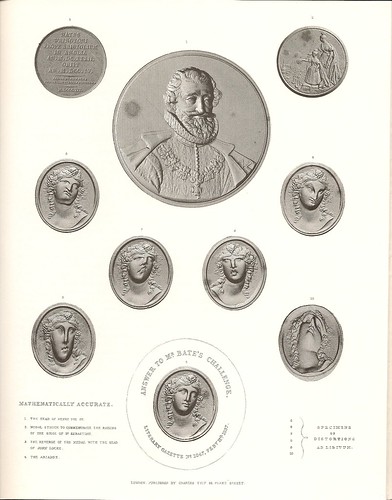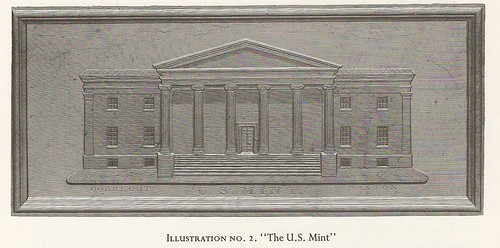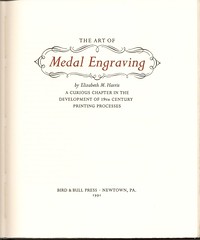
PREV ARTICLE
NEXT ARTICLE
FULL ISSUE
PREV FULL ISSUE
BOOK REVIEW: THE ART OF MEDAL ENGRAVING BY ELIZABETH M. HARRISRegarding Dick Johnson's earlier article on NUMISMATIC VOCABULARY: ANAGLYPTOGRAPHY, David Gladfelter writes: Readers might be interested in Elizabeth M. Harris's book on this topic, The Art of Medal Engraving (Newtown, Pa., Bird & Bull Press, 1991). It includes an actual plate from Collas's Tresor (my copy has plate XII) and, as an appendix, Nolte's 1837 "Memorial of Facts Connected with the History of Medallic Engraving, and the Process of M. Collas" accompanied by an engraved plate titled "Answer to Mr. Bate's Challenge" (inviting Collas to copy a medal of Ariadne without distortion).

Nolte's plate has the Ariadne medal and four others correctly engraved, together with six deliberate and hilarious distortions presented by Nolte ostensibly to prove that the results of his company's process were "quite satisfactory to every beholder whose ideas have not been disturbed by a quibble about accuracy". Harris cites Richard Doty that medal engravings did not die out in the 19th century but continued to be used well into the 20th as a security device on bank notes of about 25 countries. The undistorted Ariadne medal-ruling image or a close copy of it has been used on quite a few bank notes, some of which are in my collection.
There are 37 pages of text plus the plates David described. The Nolte appendix is an additional 12 pages. The 39 NOTES (pages 36-37) document the author's sources, ranging from histories of pantographs and pantographic copying process, to the writings of Charles Babbage, Jacob Eckfeldt and William DuBois. Note 6 provides a short biography of Joseph Saxton, one of my favorites among early U.S. Mint employees. B&B owner Henry Morris described the genesis of the book in his two-page Foreword. Here are some excerpts: Medal engraving was one of the lesser-known 19th-century graphic processes, but I think one of the most interesting. The technique produced an attractive printed image of unique character that generated wonder and admiration in 19th-century audiences, and deserves to be better known to those today who are interested in the history of the Book. I first learned of medal engraving and its use in book illustration from Elizabeth M. Harris' 1968 article Experimental Graphic Processes in England 1800-1859, which appeared in the Journal of the Printing Historical Society of that year. When I found that there were some broken copies of Collas' Tresor de numismatique available with many of the medal-engraved plates intact, I began to consider printing this book." Morris goes to great lengths to state that no books were harmed in the course of making this one: "I wish to stress that the Collas plates included here were taken from copies that were incomplete, with missing text and plate pages, and in generally falling-apart and broken condition. I would respectfully remind the reader that I am a maker of, and not a destroyer of books." It should come as little surprise to longtime NBS members that numismatic literature dealer George Kolbe was involved with the project, providing the Collas plates and original copies of other numismatic books for illustrations. Kolbe and Morris have been involved in a number of publishing projects (which would make for a great Asylum article someday).

Numismatic personalities abound in this account, including Benedetto Pistrucci, William Wyon, Jacob Perkins, Christian Gobrecht (for his 1817 medal-engraving machine) and the above-mentioned Joseph Saxton (for his ca. 1837 medal-ruling machine). Both men had a hand in the illustration of the Second U.S. Mint (shown above) in Eckfeldt and Du Bios' Manual of Gold and Silver Coins, which was based on a daguerreotype photo by Saxton. I have multiple examples of this book in my library - I like this image as one of the earliest examples of the use of photography in printing. Actually, the author notes that it "represents a combination of the three most scientific advances in graphic arts up to that time. Moreover, it could well be considered a "missing link" in the evolution of the methods used to make pictures." The book offers a fascinating history of this important aspect of printing history, offering glimpses of the personalities involved, the courtroom and business battles over competing technologies, as well as a peek at many of the technical nuances involved. Highly recommended reading for the numismatist as well as the bibliophile - stories like these are what make the history of our hobby come alive. Many thanks to David for sharing this book with us.
To read the earlier E-Sylum article, see:
NUMISMATIC VOCABULARY: ANAGLYPTOGRAPHY
(www.coinbooks.org/esylum_v13n48a12.html)
The Numismatic Bibliomania Society is a non-profit organization promoting numismatic literature. See our web site at coinbooks.org. To submit items for publication in The E-Sylum, write to the Editor at this address: whomren@gmail.com To subscribe go to: https://my.binhost.com/lists/listinfo/esylum All Rights Reserved. NBS Home Page Contact the NBS webmaster 
|
